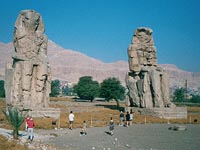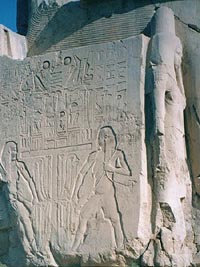Colossi of Memnon
 |
| Colossi
of Memnon |
The Colossi of Memnon (known to locals as el-Colossat,
or es-Salamat) are two massive stone statues of Pharaoh Amenhotep
III. For the past 3400 years they have stood in the Theban
necropolis, across the River Nile from the modern city of
Luxor.
The twin statues depict Amenhotep III (fl. 14th century
BC) in a seated position, his hands resting on his knees and
his gaze turned eastward toward the river and the rising sun.
Two shorter figures are carved into the front throne alongside
his legs: these are his wife Tiy and mother Mutemwiya. The
side panels depict the Nile god Hapi.
The statues are made from blocks of quartzite sandstone
which was quarried at either Giza (near modern-day Cairo)
or Gebel el-Silsila (60 km north of Aswan). Including the
stone platforms on which they stand, they reach a towering
18 metres (approx. 60 ft) in height.
The original function of the Colossi was to stand
guard at the entrance to Amenhotep's memorial temple (or mortuary
temple): a massive cult centre built during the pharaoh's
lifetime, where he was worshipped as a god-on-earth both before
and after his departure from this world. In its day, this
temple complex was the largest and most opulent in Egypt.
Covering a total of 35 ha, even later rivals such as Ramesses
II's Ramesseum or Ramesses III's Medinet Habu were unable
to match it in area; even the Temple of Karnak, as it stood
in Amenhotep's time, was smaller.
 |
| Side panel
detail |
With the exception of the Colossi, however, very
little remains today of Amenhotep's temple. Standing on the
edge of the Nile floodplain, successive annual inundations
gnawed away at the foundations – a famous 1840s lithograph
by David Roberts shows the Colossi surrounded by water – and
it was not unknown for later rulers to dismantle, purloin,
and reuse portions of their predecessors' monuments.
The Greek historian and geographer Strabo, writing
in the early years of the 1st century, tells of an earthquake
(in 27 BC) that shattered the northern colossus, collapsing
it from the waist up.
Following its rupture, this statue was then reputed
to "sing" every morning at dawn: a light moaning or whistling,
probably caused by rising temperatures and the evaporation
of dew inside the porous rock. The legend of the "Vocal Memnon",
the luck that hearing it was reputed to bring, and the reputation
of the statue's oracular powers, travelled the length of the
known world, and a constant stream of visitors, including
several Roman Emperors, came to marvel at the statues. The
mysterious vocalisations of the broken colossus ceased in
199, however, when Emperor Septimius Severus, in an attempt
to curry favour with the oracle, reassembled the two shattered
halves.
Memnon was a hero of the Trojan War, a King of Ethiopia who led his armies from Africa into Asia Minor to help defend the beleaguered city but was ultimately slain by Achilles. Whether associating the Colossi with his name was whimsy or wishful thinking on the part of the Greeks – they generally referred to the entire Theban Necropolis as the "Memnonium" – the name has remained in common use for the past 2000 years.